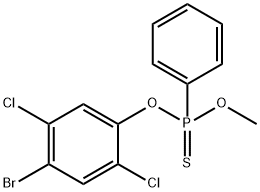LEPTOMYCIN B
- CAS No.
- 21609-90-5
- Chemical Name:
- LEPTOMYCIN B
- Synonyms
- PSL;LMB;MBCP;Abar;nk711;NK 711;Fosvel;lepton;V.C.S.;vcs5-d
- CBNumber:
- CB6293008
- Molecular Formula:
- C13H10BrCl2O2PS
- Molecular Weight:
- 412.07
- MDL Number:
- MFCD06795848
- MOL File:
- 21609-90-5.mol
| Melting point | 71-73 °C |
|---|---|
| Boiling point | 444.4±55.0 °C(Predicted) |
| Density | 1.53 g/cm3 (25 ºC) |
| Flash point | >100 °C |
| storage temp. | 0-6°C |
| solubility | DMSO (Slightly), Methanol (Slightly) |
| form | solid |
| color | White to Pale Yellow |
| Water Solubility | 2.4mg/L(25 ºC) |
| BRN | 2152663 |
| Stability | Hygroscopic, Moisture Sensitive |
| CAS DataBase Reference | 21609-90-5(CAS DataBase Reference) |
| EWG's Food Scores | 5 |
| FDA UNII | C45E8FUG3Z |
| EPA Substance Registry System | Leptophos (21609-90-5) |
SAFETY
Risk and Safety Statements
| Symbol(GHS) |    GHS06,GHS08,GHS09 |
|---|---|
| Signal word | Danger |
| Hazard statements | H300-H311-H370-H410 |
| Precautionary statements | P260-P264-P273-P280-P301+P310-P302+P352+P312 |
| Hazard Codes | T,N,Xi |
| Risk Statements | 21-25-39/25-50/53-36/37/38 |
| Safety Statements | 25-36/37/39-45-60-61-23-36-26 |
| RIDADR | 2783 |
| WGK Germany | 3 |
| RTECS | TB1720000 |
| HazardClass | 6.1(a) |
| PackingGroup | II |
| Toxicity | LD50 in adult male, female rats (mg/kg): 19, 20 orally (Gaines, Linder) |
LEPTOMYCIN B Chemical Properties,Uses,Production
Description
Leptophos is a tan, waxy solid. Molecularweight 5 412.07; Freezing/Melting point =about 70℃.Hazard Identification (based on NFPA-704 M RatingSystem): Health 3, Flammability 1, Reactivity 0. Practicallyinsoluble in water; solubility = 0.028%.
Chemical Properties
Leptophos is a tan, waxy solid
Uses
Leptomycin B is a Streptomyces metabolite that inhibits nuclear export of the human immunodeficiency virus type 1 regulatory protein Rev at low nanomolar concentrations. It covalently binds to cysteine residue in the center of CRM1/exportin 1 protein.
Uses
Insecticide.
Definition
ChEBI: O-(4-bromo-2,5-dichlorophenyl) O-methyl phenylphosphonothioate is an organic phosphonate that is phenylphosphonothioic O,O-acid in which the hydroxy groups are substituted by methoxy and 4-bromo-2,5-dichlorophenoxy groups. It is a dichlorobenzene, a member of bromobenzenes, an organic phosphonate and a phosphonic ester.
General Description
White crystalline or colorless amorphous solid, the technical product is a light tan powder. Used as an insecticide; its use is not permitted in the U.S.
Reactivity Profile
Organophosphates, such as LEPTOMYCIN B, are susceptible to formation of highly toxic and flammable phosphine gas in the presence of strong reducing agents such as hydrides. Partial oxidation by oxidizing agents may result in the release of toxic phosphorus oxides.
Health Hazard
LEPTOMYCIN B is highly toxic; it is capable of causing death or permanent injury by exposure during normal use.
Fire Hazard
(Non-Specific -- Organophosphorus Pesticide, n.o.s.) Container may explode in heat of fire. Fire may produce irritating or poisonous gases. Decomposes above 356F. Avoid strong alkalies.
Potential Exposure
A potential danger to those involved in the manufacture, formulation and application of this insecticide. Its use is not currently permitted in the United States of America
First aid
If this chemical gets into the eyes, remove anycontact lenses at once and irrigate immediately for at least15 min, occasionally lifting upper and lower lids. Seek medical attention immediately. If this chemical contacts theskin, remove contaminated clothing and wash immediatelywith soap and water. Speed in removing material from skinis of extreme importance. Shampoo hair promptly if contaminated. Seek medical attention immediately. If thischemical has been inhaled, remove from exposure, beginrescue breathing (using universal precautions, including resuscitation mask) if breathing has stopped and CPR ifheart action has stopped. Transfer promptly to a medicalfacility. When this chemical has been swallowed, get medical attention. Give large quantities of water and inducevomiting. Do not make an unconscious person vomit. Keepvictim quiet and maintain normal body temperature. Effectsmay be delayed; keep victim under observation.Note to physician: 1,10-trimethylenebis(4-formylpyridiniumbromide)dioxime (a.k.a TMB-4 dibromide and TMV-4) hasbeen used as an antidote for organophosphate poisoning.
storage
Color Code—Blue: Health Hazard/Poison: Storein a secure poison location. Prior to working with thischemical you should be trained on its proper handling andstorage. Store in tightly closed containers in a cool, wellventilated area.
Shipping
UN2783 Organophosphorus pesticides, solid, toxic, Hazard Class: 6.1; Labels: 6.1-Poisonous materials. UN3464 Organophosphorus compound, solid, toxic, n.o.s, Hazard Class: 6.1; Labels: 6.1-Poisonous materials, Technical Name Required
Incompatibilities
Incompatible with oxidizers (chlorates, nitrates, peroxides, permanganates, perchlorates, chlorine, bromine, fluorine, etc.); contact may cause fires or explosions. Keep away from alkaline materials, strong bases, strong acids, oxoacids, and epoxides. Organophosphates are susceptible to formation of highly toxic and flammable phosphine gas in the presence of strong reducing agents such as hydrides and active metals. Partial oxidation by oxidizing agents may result in the release of toxic phosphorus oxides.
Waste Disposal
Small amounts may be treated with alkali then burned in a landfill. Large quantities should be incinerated in a unit with effluent gas scrubbing. In accordance with 40CFR165, follow recommendations for the disposal of pesticides and pesticidecontainers. Must be disposed properly by following package label directions or by contacting your local or federal environmental control agency, or by contacting your regional EPA office





